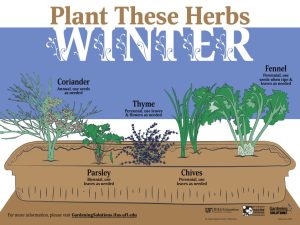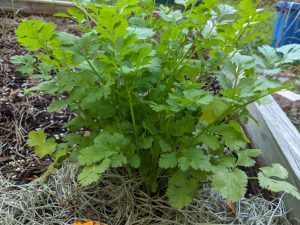This month, you will see and hear a lot about rosemary. Rightfully so! It makes for a great festive and aromatic gift during the holidays. It has a lot of positives going for it:
- Rosemary plants can be enjoyed for years.
- Rosemary has varied culinary uses in your kitchen.
- You can use rosemary sprigs to dress up holiday gifts.
Not enough? Okay, a rosemary plant is a gift that keeps on giving, as you can easily propagate more from cutting. You can make more rosemary plants to, yes, gift to others. This makes rosemary a winner for ways to save in your garden and your gift-giving budget. You’ll also be saving since it doesn’t require a lot of care or water; a reason it is featured in the Florida-Friendly plant of the month.
Now that we understand why we will hear so much about rosemary this season, let’s discuss cilantro, the actual feature of this blog.

‘Tis the season for cilantro!
Most people try growing cilantro at the wrong time of year. It then bolts (flowers) or dies, and they give up trying to grow cilantro. The time is right now, though. And, unlike rosemary, which you can (and should) plant any time of year, cilantro has a very short plant season.
Who should plant cilantro? I would say everyone but that is because I find cilantro delicious. Some folks find the flavor to be “soapy,” though. They could skip planting… unless they like coriander. Why? Because the cilantro plant (Coriandrum sativum) produces edible seeds known as, yes, coriander.
Cilantro, edible in foliage and in seeds, is a worthwhile plant for your edible garden or your decorative pot. But, it’s only worthwhile when the time is right. As we often say in edible gardening in Florida: right plant, right place, right time!
Ways to save with cilantro

Whether you want to make salsa with fresh cilantro or garam masala with coriander, or both, it all starts with planting some cilantro in full to partial sunlight, in rich and well-draining soil. If sowing cilantro seeds, note that James Stephens, a professor emeritus in the Horticultural Sciences Department at UF/IFAS Extension said the plant “has a hard seed that may need to be cracked or scarified before planting.”
For the price of seeds, you might be able to grow one cilantro plant now and enjoy using the leaves. Then, once the plant flowers and sets seeds, use some of those seeds for coriander and save others for sowing again in the fall. For more tips on ways to save with your edible gardening, sign up for our ABCs of Edible Gardening Classes. It also makes for a great plant to introduce seed saving, too.
Even if you think cilantro tastes like soap, if you garden with children, I encourage you to plant it. Why? From a sensory perspective it is worth smelling and tasting and makes for fun conversation, too. And, if you let children know that some people like cilantro while others think it tastes like soap, many will be keen to try it simply to learn where they fall on the like-dislike spectrum. You could even run a two-for-one taste test by sampling the coriander (cilantro seeds).
Finally, once cilantro blooms, you can enjoy watching pollinators visit your plant. Pollinators really appreciate the flowers on cilantro.
Resources
Planting for Pollinators
Cilantro growing, tending, harvesting, and/or storing
- Cilantro – Gardening Solutions – University of Florida, Institute of Food and Agricultural Sciences (ufl.edu)
- Five Herbs to Plant in December – Gardening Solutions – University of Florida, Institute of Food and Agricultural Sciences (ufl.edu)
Growing herbs in Florida
- Herbs in the Florida Garden – Gardening Solutions – University of Florida, Institute of Food and Agricultural Sciences (ufl.edu)
- CIR570/VH020: Herbs and Spices in the Florida Garden (ufl.edu) Be sure to click on ‘show tables’ or download if you want to see the informative chart.
 2
2
